Antenna Terminology Defined
Mobile Mark, Inc. is a leading antenna manufacturing company and supplier of antennas to wireless companies throughout the world.
Antenna theory and antenna terminology can seem complicated to the uninitiated. A lot goes into designing antennas but with a little bit of guidance and explanation, antenna users (network designers, systems integrators, end users) can read through the antenna specifications and choose the right antenna style for their wireless network design.
In this section, we will go over some simple techniques to help you better understand some terminology used and how it is applied in the Antenna industry. This will provide the reader with a wealth of knowledge that is essential for antenna selection and solutions.
So let’s get started. The Antenna Radiation Pattern is a graphical representation of the antennas radiated electrical performance. This wave of energy (electromagnetic in origin) emitted from the antenna that propagates through space is measured at a defined Angle, Amplitude, and Frequency. The measurement of this performance is commonly presented in a graphical format.
Let’s look at an Omni-directional antenna example: Think of the ripple that is created when a person throws a stone in the middle of a calm body of water (such as a pond). As the rock enters the water it causes the water all around it to rise and creates a ripple in the water.
- Think of this ripple as the “WAVE”.
- Think of the “FREQUENCY” as the number of the waves or the occurrences where the wave repeats over a period of time (from the stone to the shore).
- Think of the size in height of the wave as the “AMPLITUDE”, and
- Think of the length of the wave as the “WAVELENGTH”.
- As this wave moves outward away from the rock’s point of entry and towards the shore, the migration of this wave is called “PROPAGATION”.
Think of the letter “S” turned sideways to get a visual image of the peaks and valleys of the propagation wave. If this wave were to get smaller or squeezed and the “amount of occurrences increased” that would indicate that the frequency is getting higher. If this wave were to be stretched out longer and the “amount of occurrences decreased” then we can relate to the frequency becoming lower.
Here is an illustration that represents a “Low Frequency” vs. “High Frequency” wave.

To best describe the “ANGLE” we will approach this in two ways “Omni-directional” & “Directional”. First, think of the “ANGLE” as the direction of the wave that is traveling from the rock. (Looking down from above) as shown in Fig (1a.)
The first way- Example (1) shows an “Omni-directional” wave where the wave is traveling from the rock to the shore equally in all directions.
The second way-Example (2) shows a “Directional” wave where the wave is traveling from the rock to the shore in a defined direction.

In both examples substitute the rock for an antenna. You can now visualize the Omni-Directional and Directional Antenna wave. The measurement around this wave represents the “Azimuth” angle direction. (Similar to how one reads a compass)
Next, we will identify is the “Elevation” angle. This is the “Up” and “Down” angle from a reference plane, generally the horizon (such as the surface of the pond). For example, if you were looking through an aquarium window and the surface of the water was at eye level. Looking up you could see the sky, and looking down you could see the bottom of the aquarium. This is the elevation angle. Then look to the left or right. This is a change in Azimuth angle. So you can see there are multiple combination angles you can have.
In summary, the angle can be defined as the space between two intersecting arcs on a sphere or a figure formed by two rays sharing a common endpoint.

Understanding angle in relation to an antenna pattern is a key factor. Using this knowledge is beneficial for selecting the type of antenna needed to achieve the coverage you desire.
For example, the network design may require that an antenna be placed upon a water tower to provide coverage close in or at a moderate distance for all of the homes around the tower. Or, the network design may require that an antenna be placed upon a water tower to provide coverage of a small patch of manufacturing shops with the additional requirement that the radiated signal not go outside this area.
As you can see these are two different antenna requirements. Having the ability to select the type of antenna and a general understanding of angles associated (elevation and azimuth patterns) are vital.
The first antenna upon the water tower would be an Omni-directional antenna. This will provide coverage around the water tower (Azimuth). Knowing the angles from where the antenna will be located to the closest subscriber and the furthest is needed. These angles will then be used to select the proper antenna elevation pattern needed for best coverage.
The second antenna upon the tower would most likely be a directional type. Typically a panel, parabolic, Yagi, or log periodic style antenna that has the ability to focus the radiated energy. This will have a narrow azimuth beam width and a narrow elevation beam width.
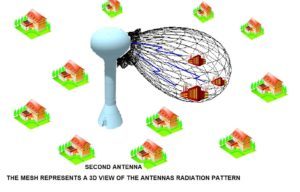
If you were to look at a side view (2D) of the first antenna (Omni-directional) this is what the elevation radiation pattern would look like reference to the elevation angle.

Now let’s look at one other terms used that I did not mention above: “Phase”. Phase is a complex function of the antenna and the surroundings. In this paper we will not discuss phase in great detail, but cover the general idea. Phase is an important factor and prior to antenna placement one should have a little understanding of its role. Having a little knowledge beforehand could save you from placing the antenna in an undesired location or configuration that affects the system performance. Phase can be constructive or destructive, by allowing the antenna to work well in performance or be destructive where it severely affects the antennas performance.
A good example would be an antenna on the rooftop with nothing around it. The signal from the antenna would propagate well. If a maintenance worker placed a large pipe right next to the antenna of equal height at ½ wavelengths away (meaning 180° in phase), the signal propagated from the antenna would reflect back off this pipe and affect the propagated wave, typically in a destructive fashion. This reflection would cause cancelation, reduction in signal, or blockage. This would be considered a destructive reflection. So if you had an Omni-directional antenna in this configuration (no-pipe) and established communication link “in one particular direction” with good signal reception, when the pipe is placed in position, the signal can be affected so greatly that a loss of communication takes place in one or multiple directions.
However, a good example of constructive phase is where a ¼ wave monopole antenna is placed just over the surface of a ground plane commonly found as the whip antenna on automobiles. Seen in (Fig 4.) and the antenna uses the reflection created by the ground plane to establish good performance. If the ¼ wave antenna were to be placed at ½ wavelength distance above the ground plane (or 180° in phase) with a large gap between, then the antenna would not work effectively. This would result in a destructive phase contribution, typically affecting the radiation pattern and the (VSWR) tuning of the antenna. Known as the “Match”. The more destructive the reflection, the greater the signal loss or the slower data performance. We will use Fig (2.) to best illustrate what phase looks like graphically. Looking at this illustration you will see a line that has smooth repetitive oscillation (up and down), commonly called a sine wave or sinusoid. Note this sinusoidal line shape that has a start and a finish.
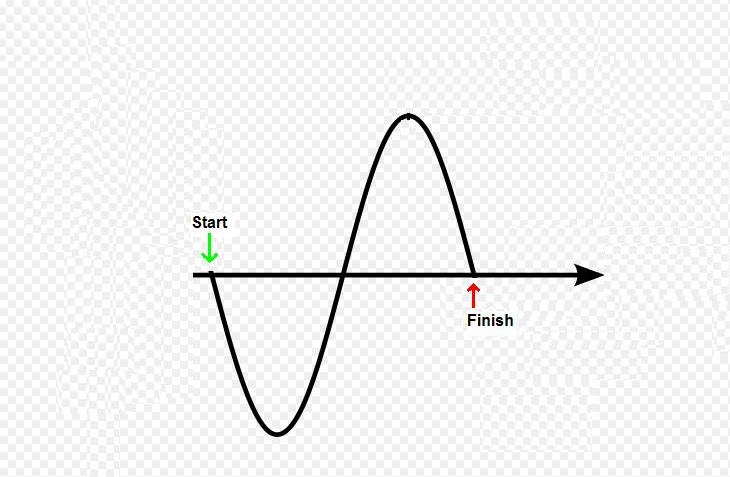
Think of the start being 0 and the end being 360. So if you were to place numbers equally spaced along this line you would have 0, 1, 2,3,4,5 etc all the way to 360. Add a degrees symbol (°) after each number and you will have the phase degrees identified over the length of this line. Now think of this line length from start to finish representing one wavelength. Below we will segment the wavelength into four equal sections. (In scientific term wavelength is identified by this symbol “λ” known as Lambda) phase is an “electrical” measurement in degrees” °” over the length of the wave.
Here we will place four points equally along this line. (4 equal sections as shown in illustration Fig (3.)
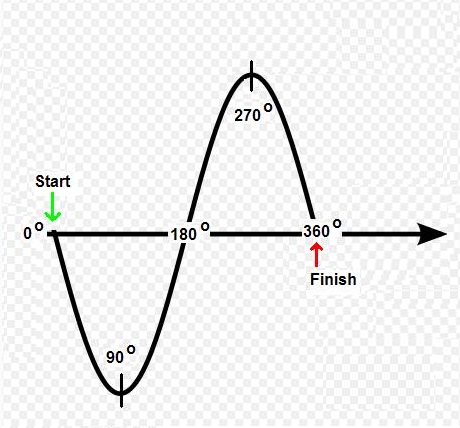
Fig (3.)
In Fig (3.) the four points represent 0°, 90°, 180°, 270°, and 360° in phase. Think of the 360° point, the start of a new cycle (occurrence) or where 0° begins again and then repeats as shown in (Fig 1.).
Think of 90° as a ¼ wavelength, 180° as a ½ wavelength, 270° as a ¾ wavelength, and 360° as one full wavelength. So we can envision when someone talks about quarter wave antenna.
For example: A “Rubber Duck Antenna” or ¼ wave monopole over a ground plane. Think of the ground plane being a metal roof of a vehicle and place the Rubber Duck antenna in the center with the antenna top end pointing straight up. See Fig (4.)
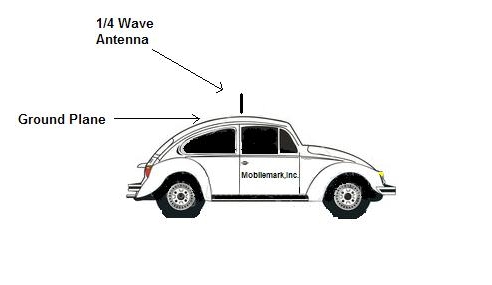
Fig (4.)
The wavelength corresponds to the velocity (speed) of the wave divided by its frequency. Below I will show you a simple formula that further explains how to calculate a wavelength for a given frequency. Using this formula will help you determine the wave length for a given frequency and you now have the ability to relate the phase. This is very helpful for antenna placement as mentioned above (constructive or destructive phase). For example: If the antenna manufacturer recommended a 2400 MHz Omni-directional antenna not to be placed closer than 10 wavelengths to the side of a utility shelter, you could then calculate what 10 wavelengths would be in inches.
11802.8 / Frequency in MHz = wavelength in inches. (in air)
Thus, 11802.8 / 2400 MHz is 4.917” or 4.917”=1 λ (One wavelength long)
Then 4.917 x 10 (wave lengths) = 49” inches
So the antenna needs to be at least 49” inches away from the utility shelter.
Let’s say, we have a special antenna and the frequency is 11,800 MHz and the wavelength is 1” in long, then we partition into four equal segments. We will have 0, ¼ ½ ¾ 1.
¼” represents ¼ λ (wavelength) and 90° in phase
½ presents ½ λ (wavelength) and 180° in phase
¾” represents ¾ λ (wavelength) and 270° in phase
1” represents 1 λ (wavelength) and 360° in phase
And the antenna manufacturer requires the antenna be placed at 360° in phase from the reflector for best performance; otherwise the radiation pattern will be severely distorted from a destructive phase contribution.
What is the distance you would select?
If you selected that the antenna placement would be 1” than you made the right choice.
Remember λ represents “Lambda” or wavelength. This symbol comes from the Greek alphabet and is used in antenna terminology quite often.
Digesting the knowledge we gained, let’s move on to what an antenna is.
An “Antenna” is a transducer or a device, designed to transmit or receive electromagnetic waves. Think of the “waves” we discussed above. Now if those waves were moving towards the antenna and the antenna received them, the antenna would convert those waves into electrical currents that the radio would use.
For example: In the first paragraph of this article, if the waves came from the shore to the stone, the stone would translate the waves (ripple) into a media that could be interpolated. Or another way to look at this is: The Radio inside a vehicle operates at a certain “Frequency” and produces a “Signal” that travels through a piece of coax to the antenna which converts the signal into an “Electromagnetic Wave” that is propagated outward. This is better known as “Radiated Energy”. The way the antenna radiates this energy or receives it is a function of its performance and is useful knowledge when selecting your antenna.
To convert the way the antenna radiates this energy or receives it to a form which we can understand and graph, an “Anechoic Chamber” is typically used for the measurement and test equipment used for interpolation. (Anechoic Chamber meaning a shielded room designed to measure electromagnetic energy. i.e. “measurement of the propagated wave in an electrically quiet area”). The antenna, which would be passive in nature, is typically measured by receiving a signal from a known source. Passive meaning there are no electronics added to the antenna that regulate the gain (amplitude) and the antenna works the same in both receiving and transmitting the signal. For active, think of a GPS that has additional electronics that amplifies the signal it receives and is not used for transmitting. This would be considered an active antenna. So let’s go back to the measurement.
When the antenna is placed in the Anechoic Chamber and measured, the measurement is then converted through electrical test equipment and mathematical functions.
The product that is produced is typically graphed so we can understand the performance. Generally called a “Radiation Pattern Plot”. The radiation Pattern Plot is usually presented in a Polar style plot or Rectangular style plot shown in Fig (5.)
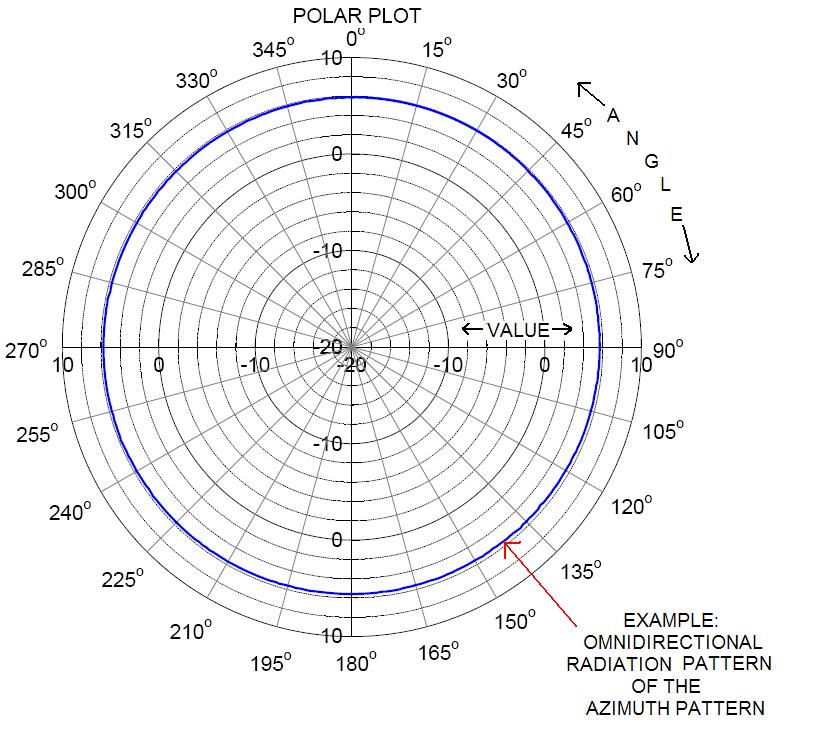
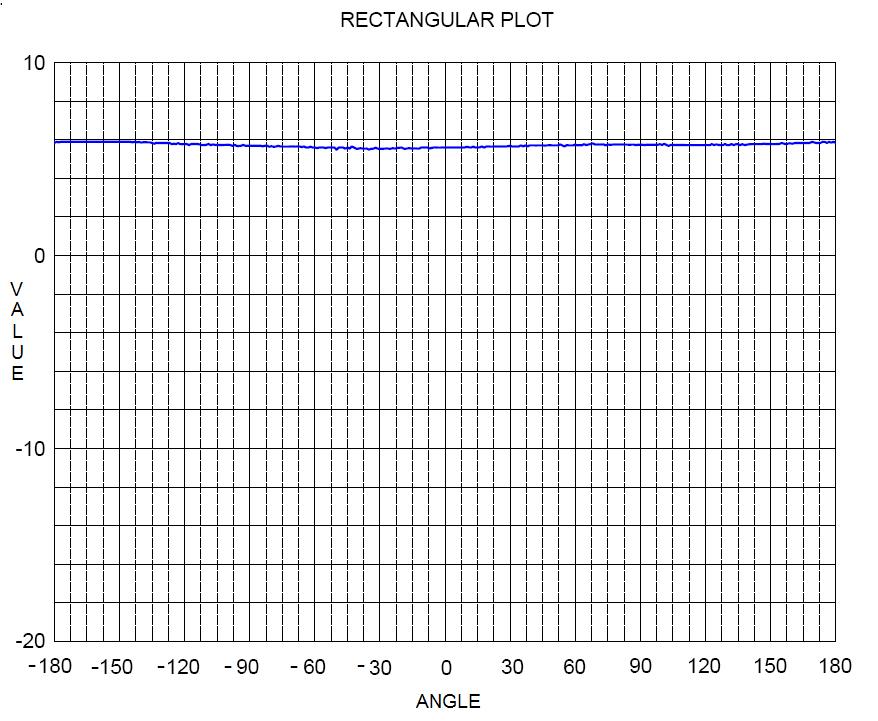
Here is a way to understand the “Polar Plot”.
Looking at the polar plot in Fig (5.) think of the Omni-directional antenna placed upon the vehicles roof as shown in Fig (4.). Now picture as if you were 100 feet above the car looking straight down. Place the car in the middle of the polar plot as shown in Fig (6.)
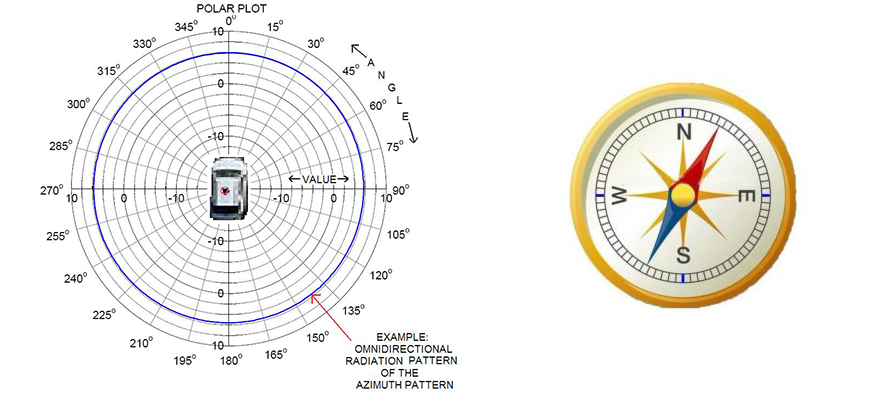
The plotted circle indicated by the arrow would be a good example of the horizontal radiation pattern of an Omni-Directional antenna.
See Fig (7.) ”Azimuth” for a better example of parallel to the earth’s horizon.
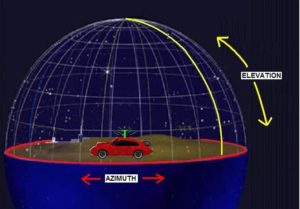
Fig (7.)
Now that we understand the polar plot, let’s discuss an easy way to understand the rectangular plot. If we were to think of the polar plot being a circle and we cut the circle, then straightened out the circle to form a straight line. It would look something like this Fig (8.)

Now apply this to an X, Y graph as viewed in Fig (5.) Very simple! Another example would be a world map compared to a globe. One is flat (rectangular) and the other is round (polar). The equator is a round circle indicated on the globe and the equator is a straight line indicated on a map from one end to the other. There you have it.
Continuing on we need to understand what an “Elevation Pattern” is. Just like the azimuth pattern the elevation pattern is an important part. You cannot have one without the other. Refer to Fig (7.) and locate the elevation label. As you will notice the arrow goes up and down and is referenced to the horizon. This is how the radiation pattern will be referenced.
Let’s look at a few more examples to better clarify. Fig (9.) is a good representation of an Omni-directional antenna mounted on a vehicle roof that highlights both the elevation and the azimuth radiated energy.
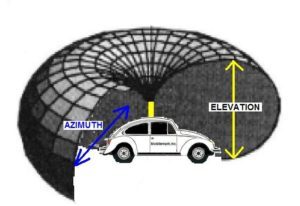
Fig (9.)
So if we were to look at one slice of the elevation radiated energy See Fig (10.) then plot it in polar format. It would look something like this.
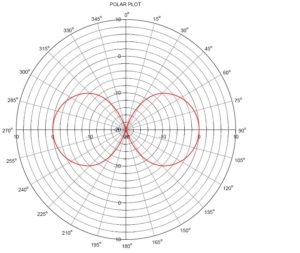
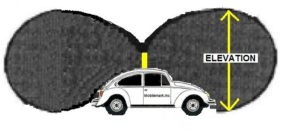
Fig (10.)
Here the elevation pattern is plotted and gives us a good representation of the vertical radiation from the antenna. It is typically plotted out in both rectangular and polar formats. More common is the polar format. Shown in Fig (9.) is a good representation of both the vertical and horizontal radiated energy in a 3 dimensional view. So when we look at the polar plot, it should be properly labeled “Elevation” or “Azimuth” and will give us a graphical representation of the antennas “propagation performance” referenced to the earth’s horizon.
Mobile Mark, Inc. designs, manufactures and delivers top technology antenna products for the global telecommunications industry. Established in 1984 and located just outside Chicago, Mobile Mark is recognized as having the experience and professionalism needed to make it all happen. We offer innovative designs, quality manufacturing, and reliable performance. Mobile Mark helps companies understand the antenna theory and antenna terminology behind the antennas for optimum wireless network coverage.
Please contact us at: info@mobilemark.com or visit our website at www.mobilemark.com for more information on antenna theory and antenna terminology.
Whitepaper Available
Complete this form to receive the Smart Grid Coverage whitepaper.
